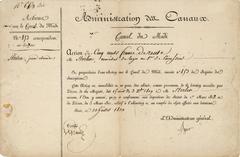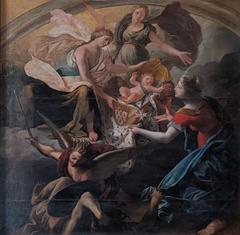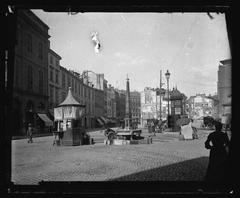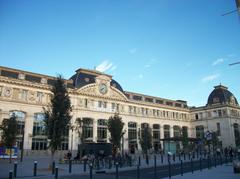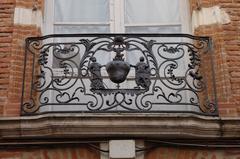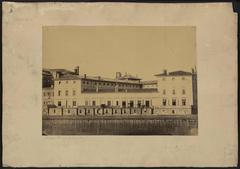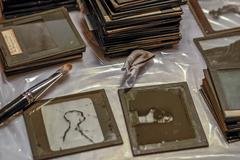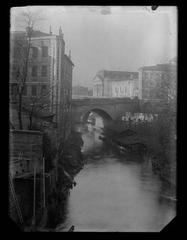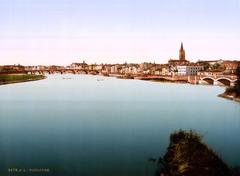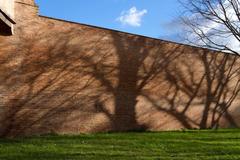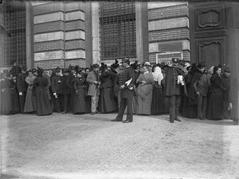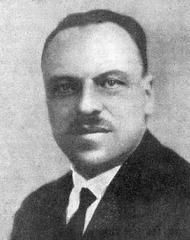Hôtel Particulier Calestroupat: Visiting Hours, Tickets, and Guide to Toulouse’s Historical Sites
Date: 03/07/2025
Introduction
Toulouse, affectionately known as the “Pink City” for its characteristic terracotta brick architecture, is renowned for its collection of hôtels particuliers—private urban mansions that narrate the city’s journey from the medieval period through the Renaissance and into the 20th century. Among these, the Hôtel Particulier Calestroupat stands out as a rare 20th-century interpretation, epitomizing both the evolution of Toulouse’s urban landscape and the aspirations of its bourgeoisie during the interwar years. Designed by architect Edmond Pilette in 1932, this mansion fuses modernist design with traditional brickwork and is notable for its striking light yellow brick façade in the Boulingrin District (POP: Plateforme ouverte du patrimoine; culture.gouv.fr).
The Hôtel Calestroupat offers a window into early 20th-century Toulouse, set amidst neighborhoods rich with Renaissance mansions, medieval towers, and lively city squares. Although primarily a private residence and generally closed to the public, its exterior is easily admired from public spaces, making it a rewarding stop for architecture enthusiasts and photographers. Special events, such as the European Heritage Days, may open its doors to visitors on rare occasions (Toulouse Tourism; monumentum.fr).
This detailed guide covers the historical evolution of Toulouse’s hôtels particuliers, a focused exploration of Hôtel Calestroupat’s architecture and heritage status, practical visitor information, and tips for exploring the Boulingrin District and nearby attractions. For an enhanced visit, consider digital tools like the Audiala app, offering immersive audio tours and up-to-date visitor information (Audiala).
Table of Contents
- Medieval Origins and Early Urban Residences
- Renaissance Flourishing: The Pastel Boom and Architectural Innovation
- Age of Parliamentarians and the Baroque Transformation
- 19th and Early 20th Century: Democratization and Imitation
- Hôtel Particulier Calestroupat: A 20th-Century Interpretation
- Visitor Information: Hours, Tickets, and Tips
- Architectural Features and Urban Context
- Cultural Significance and Heritage Protection
- Frequently Asked Questions (FAQ)
- Visual Gallery
- Explore More and Plan Your Visit
- Historical Background and Urban Integration
- Practical Visitor Tips: Access, Tours, and Etiquette
- Discovering the Boulingrin District
- Summary and Visitor Tips
- Sources
1. Medieval Origins and Early Urban Residences
The roots of the hôtel particulier in Toulouse extend to the medieval era, when influential merchant families and city officials erected fortified residences and towers as symbols of power. These early structures, several of which survive on Rue Ozenne, set the foundation for the city’s later tradition of private urban mansions (ledecode.ut-capitole.fr).
2. Renaissance Flourishing: The Pastel Boom and Architectural Innovation
The 16th-century pastel (woad) trade fueled a golden age for Toulouse’s elites, who commissioned grand hôtels particuliers with ornate brick and stone façades and lavish courtyards. Architects like Nicolas Bachelier and Louis Privat left their mark on masterpieces such as the Hôtel d’Assézat and Hôtel de Bernuy (toulouse-brique.com). By the end of the Renaissance, Toulouse boasted around 200 hôtels particuliers, 52 of which are now protected as historical monuments (fr.wikipedia.org).
3. Age of Parliamentarians and the Baroque Transformation
With the 17th and 18th centuries came the influence of the Parlement of Languedoc. Hôtels particuliers became more elaborate, featuring grand staircases, loggias, and galleries that blended local southern French elements with Parisian trends. Notable examples include Hôtel de Marvéjol and Hôtel Saint-Jean (visitesfabienne.org).
4. 19th and Early 20th Century: Democratization and Imitation
In the 19th century, the hôtel particulier style permeated more modest residences, democratizing architectural prestige with ornate façades and innovative materials—yet always retaining Toulouse’s signature brickwork.
5. Hôtel Particulier Calestroupat: A 20th-Century Interpretation
Constructed in 1932 by Edmond Pilette, the Hôtel Calestroupat continues the tradition of distinguished Toulouse mansions. Its yellow brick façade and modernist touches set it apart within the elegant, evolving urban fabric of the Boulingrin District (pop.culture.gouv.fr).
6. Visitor Information: Hours, Tickets, and Tips
Visiting Hours & Tickets
- Hôtel d’Assézat (Fondation Bemberg): Open Tuesday to Sunday, 10 am–6 pm. Adult tickets approx. €8. Guided tours at weekends.
- Hôtel Calestroupat: Generally private; open only during special events like European Heritage Days. Advance booking is advised.
Accessibility
Historic hôtels particuliers often have limited accessibility; check in advance for accommodations if you have mobility needs.
Guided Tours & Apps
Guided tours, often in English, are bookable via the Toulouse tourism office. The Audiala app provides audio guides and interactive maps for self-guided exploration.
Nearby Attractions
Most hôtels particuliers are close to the Capitole, museums, and the Garonne River, making combined visits convenient (toulouse-tourisme.com).
7. Architectural Features and Urban Context
Toulouse’s hôtels particuliers are celebrated for their inventive use of brick and stone, central courtyards, grand staircases, and richly decorated façades (lonelyplanet.fr). Hôtel Calestroupat exemplifies these traditions in a modernist idiom, with its volumetric corner placement and signature yellow brick.
8. Cultural Significance and Heritage Protection
Many hôtels particuliers, including Hôtel Calestroupat, are protected as Monuments Historiques, safeguarding their role in Toulouse’s architectural and social heritage (fr.wikipedia.org).
9. Frequently Asked Questions (FAQ)
- Can I visit inside Hôtel Particulier Calestroupat?
No, it is a private residence; interior access is typically only possible during special events. - Is there an entry fee?
No fee for exterior viewing; special guided tours during events may require advance booking. - Are guided tours available?
Guided walking tours often include the exterior; interior tours are rare and event-based. - Is it accessible for those with limited mobility?
Accessibility is limited in the historic neighborhood; check official resources before visiting. - Can I combine visits with other sites?
Yes, the location is central, with many attractions nearby.
10. Visual Gallery
Image 1: Grand brick façade of Hôtel d’Assézat (Alt: “Hôtel d’Assézat brick façade Toulouse hôtel particulier”)
Image 2: Courtyard of Hôtel de Bernuy (Alt: “Hôtel de Bernuy courtyard Toulouse Renaissance architecture”)
Image 3: Exterior of Hôtel Calestroupat (Alt: “Hôtel Calestroupat Toulouse 20th-century hôtel particulier”)
11. Explore More and Plan Your Visit
For immersive tours and updated visitor information, download the Audiala app. Stay connected via social media for updates on events, tours, and cultural programs.
For official visiting hours and tickets, consult Toulouse Tourism.
12. Historical Background and Urban Integration
Historical Background
The Hôtel Particulier Calestroupat, sometimes known as Hôtel Calespoutrat, was built during a period of urban expansion in 1932, marking a shift from Renaissance styles to modernity (POP: Plateforme ouverte du patrimoine). Architect Edmond Pilette’s commission for both the mansion and the neighboring Maison Guignard signaled a coordinated approach to urban planning in the Boulingrin District (LeFrenchGuide).
Urban Integration
Located at 1 square de Boulingrin, the mansion occupies a prominent intersection near the Jardin du Grand-Rond and allées François-Verdier (Toulouse Touristic Map). Its volumetric massing and distinctive façade create a visual anchor, blending classical symmetry with modernist restraint.
The building’s partial listing as a Monument Historique in 2018 ensures that its façades and roof are protected, influencing both conservation and new development in the area (POP: Plateforme ouverte du patrimoine).
13. Practical Visitor Tips: Access, Tours, and Etiquette
- Viewing: Admire the mansion’s exterior from public spaces around square de Boulingrin and allées François-Verdier.
- Getting There: Easily accessible via François-Verdier (Line B) metro, multiple bus lines, and major cycling routes.
- Nearby Attractions: Jardin du Grand-Rond, Toulouse Cathedral, Hôtel d’Assézat (Itinerary Expert).
- Best Time: Spring and early autumn for pleasant weather and optimal light.
- Etiquette: Respect resident privacy; do not obstruct entrances or attempt entry.
14. Discovering the Boulingrin District
Architectural and Cultural Context
Developed in the 1930s as part of the Gontaud-Biron project, the Boulingrin District features a harmonious mix of yellow, red, and white brick buildings around a central green square (culture.gouv.fr). Hôtel Calestroupat’s elegant façade and modernist terrace showcase the district’s innovative spirit (archi-tlse.over-blog.fr).
Visitor Access and Events
While the mansion is not open to the public outside of special events, the Boulingrin District is walkable and accessible, with nearby parks and heritage trails. During European Heritage Days, guided tours may provide rare interior access (monumentum.fr).
15. Summary and Visitor Tips
The Hôtel Particulier Calestroupat is a unique testament to Toulouse’s architectural evolution—bridging historical tradition and modernist innovation. Its protected status and striking presence in the Boulingrin District make it a must-see for visitors interested in architecture and urban history (POP: Plateforme ouverte du patrimoine; culture.gouv.fr).
Visitor Tips:
- Admire the mansion from surrounding public spaces.
- Plan your visit during European Heritage Days for possible interior access.
- Use the Audiala app for self-guided tours.
- Combine with visits to nearby parks, museums, and heritage sites.
- Always respect resident privacy and follow local guidelines.
16. Sources
- ledecode.ut-capitole.fr
- POP: Plateforme ouverte du patrimoine
- Toulouse Tourism
- culture.gouv.fr
- monumentum.fr
- lonelyplanet.fr
- toulouse-brique.com
- visitesfabienne.org
- fr.wikipedia.org
- Itinerary Expert
- archi-tlse.over-blog.fr

